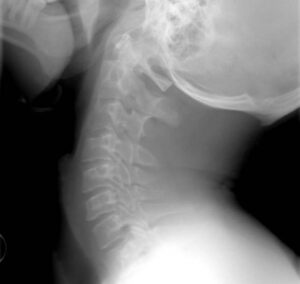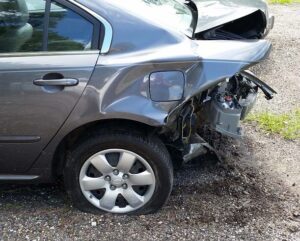
Whiplash Lawsuits and Injury Claims After an Auto Accident

When many people think about whiplash, the first thing that comes to mind is the hobbling “victim” with a fake neck brace followed by his ambulance-chasing attorney.
While frivolous lawsuits certainly do exist, whiplash is legitimately one of the most common injuries suffered in automobile accidents.
As with most injuries, the symptoms suffered can range from mild to excruciating. In more severe cases, whiplash can cause major life disruptions, long term pain and discomfort, or even permanent disability.
If you’ve been in an accident and suffered a whiplash injury, don’t face the insurance companies on your own. Contact our Wake Forest car accident attorney today.
What is Whiplash?
Whiplash is not a medical term. The term whiplash generally refers to any neck strain that occurs when your neck jerks forward and back abruptly (hyperflexion and hyperextension), causing muscles and tendons to stretch or tear. Whiplash can be due to any kind of impact, such as those common to collision sports, but it is most often referred to regarding auto accidents.
Whiplash does not require a high-speed impact, and can commonly occur after seemingly minor crashes. Depending on the occupant’s seating position and relative weight of the colliding vehicles, a low speed impact is capable of causing significant injury.
What Are the Symptoms of Whiplash?
The symptoms of whiplash include:
- Neck pain and stiffness
- Loss of range of motion
- Headaches
- Dizziness
- Fatigue
- Pins and needles or numbness in the arms
- Ringing in the ears
- Irritability
- Loss of sleep
- Blurred Vision
Some of these symptoms can also be indicative of a concussion, so it is important to seek medical attention immediately if you experience any of these feelings. In fact, it is advisable to seek medical attention after any car accident, since some of these symptoms may not be immediately noticeable.
After a traumatic experience such as a car accident, your body releases endorphins that act as natural painkillers, which may temporarily mask your injuries.
What is the Treatment for Whiplash?
In most cases, doctors will prescribe over the counter pain killers. In more severe cases, they might choose prescription pain killers or muscle relaxers. In addition to medication, whiplash treatment may include:
- Icing the affected area
- Doing exercises to strengthen
- Stretching
- Chiropractic care
- Acupuncture
- Massage
- Electronic Nerve Stimulation
Foam collars may also be used to stabilize the neck after an injury, but they are generally only used for a short amount of time, as prolonged use can weaken the muscles.
Making an Injury Claim for Whiplash
Immediately following a traumatic event such as a car accident, it can be especially challenging to collect your thoughts. However, following a few guidelines can help you down the line if you eventually end up filing a whiplash injury claim.
The first thing to do is make sure everyone is safe, and move to a location where no one is in danger. If possible, turn your vehicle’s hazard lights on and use cones, warning triangles, or flares to alert traffic.
Stay Calm
Do not apologize to any other parties involved or to the police. It is natural to be inclined to say “sorry” out of common politeness, even when something is not your fault in any way. However, for an insurance adjuster whose job is to pay out as little money as possible, any mention of the word “sorry” may imply contributory negligence.
Conversely, you also don’t need to point fingers and act confrontationally. This will only make the other party more defensive, and you don’t want to paint yourself as aggressive and belligerent.
Locate Witnesses
You should identify any possible witnesses as soon as possible, and make sure to collect their contact information. Witnesses can be extremely valuable in making your case. Not only can they potentially backup your story, but they may be able to provide additional details you couldn’t observe from your own perspective.
Contacting witnesses in a timely manner is very important. The longer you wait, the murkier people’s memories become; making their account of the incident less valuable. As their memory fades, witnesses could also unintentionally make statements that are contradictory to the facts, potentially casting doubt on your version of events.
Gather Evidence and Document Injuries

Much like your witnesses’ memory, the other physical evidence surrounding the incident will fade as well. Cuts and bruises will heal, damaged cars will get fixed, and skid marks on the road will wash away. Taking photos of these pieces of evidence will preserve them until they are needed to prove your side of the story.
Seeking medical attention immediately after a crash is very important for your own health and well-being, but it is also a crucial step in documenting your injuries. If you are trying to seek compensation for debilitating injuries several months after an accident, it’d be pretty peculiar if you never sought any type of treatment.
Follow your doctor’s orders. If your doctor prescribes pain medicine or suggests follow up visits, follow the recommended treatment. If you fail to do so, it could be construed that your own actions contributed to your continued pain and suffering.
Since a soft tissue injury like whiplash may not manifest itself visually like broken bones or lacerations, another good way to document your injuries is to keep a daily journal. Every time you experience pain, write it down and describe it in a very objective manner.
The purpose of this journal is to help you with your own recollection of your pain and suffering. You should not disclose your journal to any other parties other than your own lawyer.
Sending a Demand Letter
The demand letter is the starting point of the negotiation process with the insurance company. It is very important to draft this letter correctly, so we highly advise seeking the advice of an experienced personal injury lawyer.
In your demand letter, you will explain to the insurance company:
- What happened
- Why the other person was at fault
- What injuries you sustained
- What damages you suffered
- Your demand to settle your claim (in most instances).
The damages may consist of a number of things, including medical expenses, income loss, and pain and suffering.
Determining Pain and Suffering/Non-Economic Damages
Every injury case is different and there is no precise formula to calculate pain and suffering damages. A common way to estimate the pain and suffering component of an injury settlement is to take the total amount of money spent on medical diagnosis and treatment and multiply it by a certain number.
However, there are many other factors that go into determining what is a fair recovery for pain and suffering. Such things as the type of injury, the part of the body involved, the length of time for recovery, scarring, impacts on physical activity, etc. The services and advice of an experienced personal injury attorney are vital to helping you determine a fair and appropriate number.
Don't Face the Insurance Companies Alone
If you’ve been in an automobile accident and suffered a neck injury, stay calm, seek medical attention, and be extra vigilant in documenting your injuries and treatment.
Be wary of the quick settlement offer from the insurance company. Once you take their check and sign a release, you are forever prevented from seeking a larger recovery, even if you later determine your injuries are far more severe than first thought.
Contact The Doyle Law Offices Today
If you've suffered from whiplash or other injuries as the result of an auto accident, get the compensation you deserve. Call The Doyle Law Offices P.A. at (984) 235-1067 or fill out the contact form below.
"*" indicates required fields
